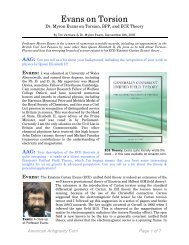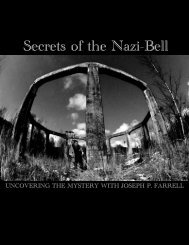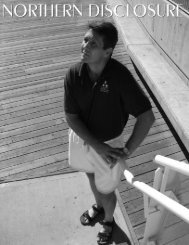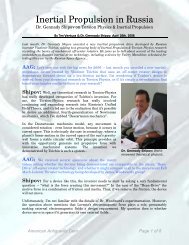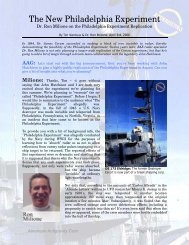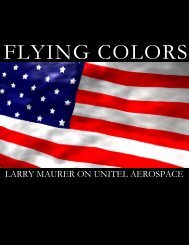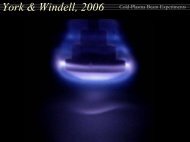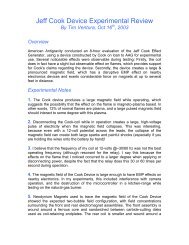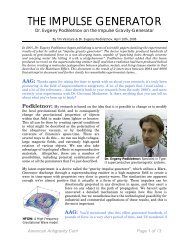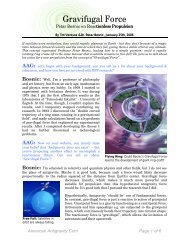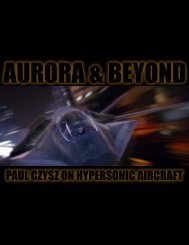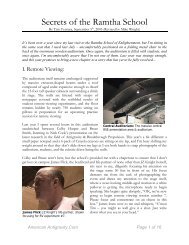The Nazi Bell - American Antigravity
The Nazi Bell - American Antigravity
The Nazi Bell - American Antigravity
You also want an ePaper? Increase the reach of your titles
YUMPU automatically turns print PDFs into web optimized ePapers that Google loves.
<strong>The</strong> <strong>Nazi</strong> <strong>Bell</strong><br />
<strong>American</strong> <strong>Antigravity</strong>.Com Page 1 of 17<br />
By Tim Ventura
<strong>The</strong> <strong>Nazi</strong> <strong>Bell</strong><br />
Originally Entitled “Einstein’s <strong>Antigravity</strong>”<br />
By Tim Ventura with revision by John Dering<br />
Part 1. Nick Cook’s Mysterious Discovery<br />
During the course of researching his best-selling book, “<strong>The</strong> Hunt for Zero Point”, Nick<br />
Cook stumbled upon World War II era evidence for a secret <strong>Nazi</strong> Weapon that came to be<br />
known as the “<strong>Nazi</strong> <strong>Bell</strong>” device. This device was constructed by a scientific team reporting<br />
to SS General Hans Kammler under a veil of secrecy even deeper than that of the <strong>Nazi</strong><br />
nuclear research.<br />
While Cook’s research yielded little<br />
information about the specific design or<br />
application of the <strong>Nazi</strong> <strong>Bell</strong> device, his<br />
sources indicated that it apparently was able<br />
create a variety of startling effects on nearby<br />
objects. It has been speculated that the <strong>Bell</strong><br />
device was designed to use high-speed<br />
counter-rotating components filled with<br />
specialized materials and energized by<br />
electromagnetic energy to induce “torsion”<br />
effects and thus control gravity and other<br />
significant effects.<br />
<strong>Nazi</strong>-<strong>Bell</strong>: Closeup of a test-platform at the<br />
secret Wenceslas Mine facility in Poland.<br />
John Dering, a physicist specializing advanced directed energy, nonlinear electrodynamics<br />
and new energy sources has further reported on a “Rhine Valley” facility and device. He<br />
believes this to have been an actual wartime prototype deployment of a successor to the<br />
<strong>Nazi</strong> <strong>Bell</strong> experiments, which were carried out in the Wenceslas Mine research lab in<br />
occupied Poland. While the <strong>Bell</strong> experiment was focused on developing a radical new<br />
propulsion technology, the little-known Rhine Valley experiment may have been a last-ditch<br />
attempt to weaponize the <strong>Bell</strong>’s dangerous side effect for use against Allied forces.<br />
Nick Cook: Janes Defense<br />
Weekly Aviation Editor &<br />
investigative author.<br />
Dering speculates that the German WW-II research was<br />
intended to create a powerful propulsion effect by engineering<br />
application of Einstein’s Unified Field <strong>The</strong>ory (UFT)<br />
equations. Within the 1929 version of the Einstein UFT<br />
equations a linkage is found between the “vector magnetic<br />
potential” and Torsion. Put simply, in the Unified Field<br />
<strong>The</strong>ory the effects of curved space-time (resulting from a<br />
massive body, like the earth) can locally offset by creating<br />
Torsion. Thus electromagnetic interactions are harnessed to<br />
induce torsion, which in turn can then null out gravitation.<br />
This astounding possibility for gravity control is not predicted<br />
<strong>American</strong> <strong>Antigravity</strong>.Com Page 2 of 17
in either the special or general relativity theories and appears only in the Unified Field<br />
equations. Thus, a sort of counteraction to gravity or “antigravity” field would be the result.<br />
<strong>The</strong> heavy-duty concrete construction of the test-rig at the Wenceslas Mine, complete with<br />
heavy steel mounting-rings, bears witness to the massive scale of the forces that the research<br />
produced.<br />
While the full purpose and results of neither experiment is completely known, it is obvious<br />
that <strong>Nazi</strong> <strong>Bell</strong> possessed a great deal of value in terms of secret-weapons – with a range of<br />
choices at his disposal at the end of World War II, Hans Kammler considered only the <strong>Nazi</strong><br />
<strong>Bell</strong> experiment as being valuable enough to save Germany from the encroaching Allied &<br />
Russian forces. <strong>The</strong> <strong>Bell</strong> project [whatever its full purpose] was the only research program in<br />
<strong>Nazi</strong> Germany to carry the designation “War Decisive”. Not even the German atomic bomb<br />
or rocket programs were considered of such importance!<br />
Historically speaking, the German’s motive for developing the <strong>Nazi</strong> <strong>Bell</strong> device seems<br />
apparent. Hitler’s Third Reich had an almost borderline obsession with secret “wunder” and<br />
“uber-weapons” that they felt would give them an advantage against the Allies. <strong>The</strong> wild<br />
success of the V-2 rocket program had emboldened them to undertake the development of<br />
even more esoteric weapons projects – such as the world’s first jet fighter, the ME-262, and<br />
a series of jet-powered Coanda-Effect UFO prototypes (radical disk shaped VTOL aircraft<br />
designs that proved ultimately unsuccessful). <strong>The</strong> most notable of these was a design by<br />
Andreas Epp, which became an inspiration for the later AvroCar experiments of the 1950’s.<br />
Coanda Effect: A<br />
prototype flying disk<br />
design by Andreas Epp.<br />
Neither the ME-262 nor the Coanda-Effect disk devices were<br />
ready in time for use against the Allies, but nonetheless<br />
received the backing of the Third Reich, which supplied them<br />
with trained scientists, materials and research funding, and a<br />
nearly endless supply of slave-labor with which to build the<br />
projects.<br />
It’s not known where the true inspiration for the <strong>Nazi</strong> <strong>Bell</strong><br />
device & prior Rhine-Valley experiments originated, but its<br />
possible to speculate that they were trying to leap to a<br />
completely electromagnetic propulsion system after realizing the limited potential in<br />
controllability and speed from their experimentation with the Coanda-Effect saucer<br />
technology. Perhaps some of the more forward-thinking physicists had the ear of Hans<br />
Kammler, and suggested to him that the time was right to evolve to a technology so far<br />
ahead of aerodynamic propulsion of the day that it would give Germany absolute supremacy<br />
in the air. Darker possibilities exist, given that the <strong>Bell</strong> Device<br />
researchers appeared very interested in the dangerous and lethal<br />
side effects created by exposure to the <strong>Bell</strong> force field.<br />
Assuming that the <strong>Nazi</strong>’s had decided on a nearly fictional<br />
approach to directly interacting with gravity through<br />
electromagnetism, the next logical step that they would have<br />
taken is to find a scientific basis to work from. As scientists,<br />
Kammler’s team would have quickly realized that this scientific<br />
support wouldn’t have come from either Relativity <strong>The</strong>ory or<br />
Hans Kammler: A rare<br />
photo of the SS General<br />
behind the <strong>Bell</strong> project.<br />
<strong>American</strong> <strong>Antigravity</strong>.Com Page 3 of 17
Quantum Mechanics, but they wouldn’t have had to search very far, as the Germans had<br />
already reviewed just such a theory to unify Electromagnetism and Gravitational Forces …<br />
On June 14 th , 1928, a paper was published in German that would have certainly attracted the<br />
attention of anyone looking for a quick and easy way to convert from electricity to<br />
gravitational force. <strong>The</strong> English translation of the title is: “New possibility for a Unified Field<br />
<strong>The</strong>ory of Gravitation and Electricity”, and it contains the beginnings of what later became<br />
known as Torsion <strong>The</strong>ory. Despite the <strong>Nazi</strong> dislike for Jewish science and culture, this paper<br />
was written by a physicist too renowned to be ignored – quite possibly the world’s greatest<br />
physicist, Albert Einstein!<br />
Starting in the early 1920’s Einstein and others began to speculate that general relativity,<br />
which describes gravitation and space-time, could be modified to include the laws of<br />
Maxwell that describe electromagnetism. In essence Einstein sought to show that the laws of<br />
electricity and magnetism could be “unified” with the laws of gravitation. In other words<br />
such a theory would imply that all electrical and magnetic effects and all gravity effects are<br />
manifestations of an underlying “unified field”. By the late 1920’s Einstein’s papers on<br />
Unified Field theory began to be read by physicists interested in exploring experimental<br />
verification of his theories.<br />
John Dering has suggested that in addition to a general familiarity with Einstein’s Unified<br />
Field <strong>The</strong>ory from written publications, the <strong>Nazi</strong>’s may have in fact had “inside information”<br />
on the subject. Supposedly, Gerlach had discussed the foundations of this new Unified Field<br />
<strong>The</strong>ory at length with Einstein while the theory was being formulated, and had also<br />
collaborated with Einstein during the 1920’s on a search for experimental verification. As<br />
history tells us, Gerlach was later appointed to the position of “plenipotentiary” for <strong>Nazi</strong><br />
Fission Research in 1944 by the Reich Research Council – giving him top-level scientific<br />
connections throughout Germany’s cutting-edge research programs. Nick Cook has also<br />
highlighted Gerlach’s connection to the <strong>Nazi</strong>-<strong>Bell</strong> project through the testimony of defense<br />
journalist Igor Witkowski, who claims to have been shown documents identifying Gerlach’s<br />
involvement in the project.<br />
Thus, with the driving goal of building an electromagnetically powered UFO to replace the<br />
less than spectacular performance of the Coanda-Effect flying disks, Kammler’s scientific<br />
team would have already been familiar with Einstein’s work in gravity, and would have had a<br />
real basis from the published UFT tensor equations to begin rapid experimentation with a<br />
new technology for 1940’s era <strong>Antigravity</strong>!<br />
Part II. <strong>The</strong> Philadelphia Experiment<br />
<strong>The</strong> <strong>Nazi</strong>’s weren’t the only people interested in utilizing high-power electromagnetic fields<br />
in the development of secret weapons during World War II. <strong>The</strong> Allies were also busy in the<br />
development of a number of secret projects, including the well-known Manhattan Project<br />
that led to the development of the atomic bomb, as well as Von Neumann’s work leading to<br />
computer code-breaking for Axis code-encrypted communications.<br />
<strong>American</strong> <strong>Antigravity</strong>.Com Page 4 of 17
<strong>The</strong> mythology gets pretty deep here, as it suggests that Von Neumann was also involved in<br />
setting up another project – the ill-fated “Project Rainbow” or “Mirage”, which came to be<br />
known later as “<strong>The</strong> Philadelphia Experiment”.<br />
<strong>The</strong> real story behind the Philadelphia<br />
Experiment may never be known, and the<br />
primary sources of information about it come<br />
primarily from a merchant Marine sailor<br />
named Carl Allen (a.k.a. Carlos Allende), as<br />
well as an anonymous source known only<br />
under the pseudonym ‘Dr. Franklin Reno’.<br />
Author William Moore interviewed both<br />
Reno and Allende during research for his<br />
book “<strong>The</strong> Philadelphia Experiment” -- while<br />
both men offer different perspectives on the<br />
experiment, they agree in principle of a<br />
variety of key points.<br />
USS Eldridge: Was the DE-173 part of an<br />
accidental teleportation & invisibility project?<br />
<strong>The</strong> original story about the Philadelphia Experiment surfaced in the form of three letters<br />
from Carlos Allende (later known to be Carl Allen), sent to a Dr. Morris K. Jessup after the<br />
1955 publication of Jessup’s book entitled, “<strong>The</strong> Case for the UFO”. <strong>The</strong> rambling, often<br />
incoherent writing in the letters described an experiment with the purported goal of making<br />
a ship invisible to radar – but in Allende’s words, the ship suffered a mysterious accident,<br />
rendering it temporarily invisible but having horrible biological side effects on the ship’s<br />
crew. Carlos Allende claimed to have seen this experiment from his post on a nearby<br />
observational Liberty ship, “<strong>The</strong> S.S. Furuseth”, positioned in Philadelphia Harbor.<br />
Dr. Franklin Reno, who apparently had been in hiding for several years when Moore finally<br />
interviewed him, claimed that his role had been as an assistant to a Dr. Albrecht and<br />
ostensibly also to Dr. Von Neumann on some of the mathematical calculations required to<br />
vet the physics for government buyoff on the project. Reno described to Moore performing<br />
calculations for a 10% deflection in light, and also mentions working to some degree with<br />
Einstein’s Unified Field <strong>The</strong>ory, which reinforces the idea that the Philadelphia Experiment<br />
was performed with the intent of making the USS Eldridge invisible to both radar and visible<br />
light. In effect, Reno described a real-life “Mirage Effect” nearly identical to the fictional<br />
invisibility device later portrayed in the 1987 science-fiction movie “Predator”.<br />
One of the real problems with regard to the Philadelphia Experiment story has been the<br />
amount of mythology surrounding it. In many ways, it serves as a modern-day extension of<br />
the many “ghost ship” tales such as the story of the Flying Dutchman from earlier eras.<br />
Different retellings of the Philadelphia Experiment tale always seem to contain a unique<br />
twist – in some stories, the experiment was meant only to produce radar-invisibility to<br />
provide the Navy with a means of avoiding enemy radar while traveling in convoys.<br />
Radar was still a very new and emerging technology in 1943, and one of the chief complaints<br />
about the ‘radar-invisibility’ explanation for the Philadelphia Experiment is quite simply that<br />
German radar had not yet become a major problem for the Allies. However, another<br />
<strong>American</strong> <strong>Antigravity</strong>.Com Page 5 of 17
etelling of the story offers an interesting twist to this “cloaking device” theory, in the form<br />
of making the Eldridge literally invisible to the naked eye.<br />
This alternative claim is that German battleships used very precise optical sights on the top<br />
of tall masts for “over the horizon” range finding, and that by creating a mirage effect<br />
around the hull of the Allied ships, it would limit the German’s ability to accurately gauge the<br />
distance and elevation for their battleship cannons. This “mirage effect” has been supposed<br />
to come from different possible sources – one idea is that it was accidentally discovered as a<br />
by-product of high-frequency resonant coil devices found by Tesla during earlier research.<br />
Albert Einstein: Worked<br />
for the Navy during WWII.<br />
Another possibility is that Einstein himself invented the<br />
“mirage effect” in 1943, during a consultancy period in which<br />
he worked for the US Department of the Navy by the<br />
appointment of Dr. Vannevar Bush. Einstein’s FBI file places<br />
him in the right place at the right time – working for the<br />
Navy’s Bureau of Ordinance on what was officially described<br />
as “a device to explode a torpedo under a ship”. This has been<br />
presumed to suggest that Einstein at least participated in the<br />
Philadelphia Experiment, as his skills would have otherwise<br />
been far more valuable to something like the Manhattan<br />
Project than a simple exercise in mechanical engineering.<br />
<strong>The</strong> exact goals of the Philadelphia Experiment aren’t known, and could even have been as<br />
mundane as finding a way for the Allies to create EM interference with torpedoes and mines<br />
of the day – however, what is known about the experiment is that the results were far from<br />
what were anticipated.<br />
By cross-correlating stories from a number of sources, we can<br />
ascertain that the core-theme of these tales revolves around<br />
the USS Eldridge disappearing at port in Philadelphia Harbor<br />
in a fog of “green mist”. Supposedly, the ship faded from<br />
view, until the entire ship itself was eventually invisible –<br />
leaving in its place only a ship-sized hole in the water to<br />
indicate that it was still present. A neat trick, to be sure, but<br />
the side effects tell the more interesting story…<br />
Invisibility: Reports claim<br />
that only a ship-sized hole<br />
in the water remained.<br />
In addition to bending light around itself, the USS Eldridge seems to have experienced a<br />
number of intense anomalistic effects, including teleportation and/or time-displacement. It’s<br />
difficult to confirm most of these, but they include men melting into the decks of the ship,<br />
and a rumor persists that in addition to causing insanity in many of the crewmen, the crew<br />
also carried residual field-effects within themselves: a brawl was reported the night after the<br />
test had been conducted with a report that two of the crew members had literally vanished<br />
into thin air in front of a waitress.<br />
<strong>The</strong> reported side-effects of the Philadelphia Experiment were are too diverse to completely<br />
describe in this overview, and its difficult to tell which effects really occurred and which are<br />
the product of wishful thinking. As it turns out, the world would be forced to wait nearly 40<br />
years for any kind of validation about the Philadelphia Experiment …<br />
<strong>American</strong> <strong>Antigravity</strong>.Com Page 6 of 17
Part III. An Accidental Replication?<br />
<strong>The</strong> connection between the <strong>Nazi</strong> <strong>Bell</strong> & Rhine Valley experiments and the Allied<br />
Philadelphia Experiment of World War II may quite possibly come from a very unexpected<br />
source – a Canadian inventor by the name of John Hutchison.<br />
John Hutchison: <strong>The</strong><br />
Canadian inventor who<br />
discovered the H-Effect.<br />
Hutchison is a rather unique character – he collects and tinkers<br />
with a variety of electronic gadgets at a small apartment that<br />
he’s converted into a laboratory in Vancouver, BC. In addition<br />
to a collection of Tesla Coils and Van De Graaf generators, he<br />
also has several RF-amplifiers and an assortment of surplus<br />
Naval electronics equipment that he’s purchased from auctions<br />
at the nearby shipyards. What makes Hutchison unique is that<br />
he has an eye for putting things together, and has been able to<br />
produce some rather spectacular effects simply through<br />
adjusting his equipment correctly.<br />
Hutchison seems to be the middle ground between the <strong>Antigravity</strong> effects reported from the<br />
<strong>Nazi</strong> <strong>Bell</strong> experiments and the melting-materials effects of the Philadelphia experiment. His<br />
experimentation with high-voltage and high-frequency apparatus has produced effects<br />
ranging from antigravity and levitation in a variety of materials, to the melting and<br />
jellification of materials – including substances melting into each other at room temperature.<br />
<strong>The</strong> effects range in scope and scale quite profoundly – in<br />
some occurrences the levitation only lifts a few grams, while in<br />
another instance a several hundred pound cannon ball was<br />
captured on tape hovering in mid-air.<br />
Hutchison has collected an abundance of evidence to support<br />
his research – including hours of video and reels of film, as<br />
well as deformed samples of metals subjected to roomtemperature<br />
melting and jellification, and enough other<br />
supporting evidence to convince even the most jaded skeptic<br />
that these effects do indeed occur as they’ve been described.<br />
Levitation: <strong>The</strong> H-Effect<br />
can levitate objects up to<br />
several hundred pounds.<br />
Hutchison has further backed his story by allowing independent scientific teams to examine<br />
these effects as they happen – including at one point a 6-month study conducted by a CIA<br />
research time financed by Col. John Alexander, which supported the veracity of his unusual<br />
experiments, but were unable to explain the basis for the Hutchison Effect.<br />
Hutchison himself does not work in a theory-based environment – his research, for<br />
whatever the reason, evolved in a hands-on setting, which means that he understands how to<br />
establish the environment that creates the effects that he’s achieved, but these effects are<br />
<strong>American</strong> <strong>Antigravity</strong>.Com Page 7 of 17
nonetheless largely random and difficult to predict. Hutchison spends most of his time<br />
tinkering, and the biggest challenge remains a fundamental understanding of why and how<br />
he’s able to do what he does.<br />
Anomalies: This steel<br />
ingot was crushed into<br />
powder from the H-Effect.<br />
<strong>The</strong> scope and complexity of John Hutchison’s work is vast<br />
enough that a number of researchers have speculated on its<br />
application to a variety of alternative-science concepts and<br />
disciplines. In this particular case, however, it is the correlation<br />
of the effects and side effects of the Hutchison Effect with the<br />
<strong>Nazi</strong> <strong>Bell</strong> experiments and the Philadelphia Experiment that is<br />
of the greatest interest. Hutchison’s work, which has been well<br />
recorded and extensively documented, seems to provide<br />
validation for both of these World War II era experiments,<br />
despite their inherent lack of validating evidence.<br />
Hutchison’s work seems more closely related to the Philadelphia Experiment in practice<br />
than it does to the <strong>Nazi</strong> <strong>Bell</strong> experiments – after all, both the H-Effect and Philadelphia<br />
experiment seem to have utilized high-power Tesla equipment, such as resonant coils and<br />
rotating fields. Neither of those experiments seems to have utilized mechanical rotation to<br />
any degree, whereas the <strong>Nazi</strong> <strong>Bell</strong> seems to have been designed specifically to enhance these<br />
effects.<br />
<strong>The</strong>re’s a final factor that makes Hutchison’s work especially notable: his experiments don’t<br />
produce negative biological side effects. This may be the result of the higher-frequencies that<br />
Hutchison uses experimentally – the H-Effect occurs between 10 to 20 megahertz, instead<br />
of working in the kilohertz range like the <strong>Bell</strong> Device, or the 10 – 125 Hz range that Corum<br />
suggested for the Philadelphia Experiment. Do the higher-frequencies make his device more<br />
efficient, or simply put the field-effects out of the range that damages living organisms?<br />
Part IV. John Dering’s Speculation on the <strong>Nazi</strong> <strong>Bell</strong><br />
One of the lessons that the World War II era experimentation with Einstein’s Unified Field<br />
<strong>The</strong>ory teaches us is that these forces can be hazardous or downright dangerous if a careless<br />
or hasty approach is taken in developing them. <strong>The</strong> crew of the USS Eldridge appears to be<br />
representative of the biological hazards that have become apparent, and it has been claimed<br />
that experimentation with the <strong>Nazi</strong> <strong>Bell</strong> also caused human casualties.<br />
Risks and hazards aren’t new to the process of scientific discovery -- many new technologies<br />
carry with them dangerous risks if not handled with care, and over the last few years several<br />
private organizations and individual researchers have begun a cautious exploration of these<br />
effects with an eye to developing a better understanding of how to harness this technology<br />
while minimizing potential health concerns.<br />
John Dering is one of the primary advocates of renewed support in experimentation with<br />
Einstein’s Unified Field <strong>The</strong>ory and several other related approaches to <strong>Antigravity</strong> and newpropulsion<br />
concepts. Dering works at SARA Inc, a California aerospace & defense<br />
<strong>American</strong> <strong>Antigravity</strong>.Com Page 8 of 17
contractor involved with a variety of development projects based on breakthrough<br />
innovations in technology.<br />
Dering is the first to acknowledge that this approach to technology carries risks – he’s<br />
commonly used the phrase “when you pull the cat’s tail you get the whole cat”, by which he<br />
means that since the Unified Field <strong>The</strong>ory taps into multiple forces by warping the spacetime<br />
manifold, tampering with a single force such as gravity will undoubtedly have sideeffects<br />
that show up in unrelated forces as well.<br />
Dering’s concern for the biological risks associated with UFT research is echoed by Nick<br />
Cook’s description of the <strong>Nazi</strong>-<strong>Bell</strong> experiment, “During the tests, the scientists placed<br />
various types of plants, animals, and animal tissues within the <strong>Bell</strong>’s sphere of influence.<br />
In the initial test period of November to December 1944, almost all of the samples were<br />
destroyed. A crystalline substance formed within the tissues, destroying them from the<br />
inside; liquids, including blood, gelled and separated into clearly distilled fractions.”<br />
Cook further described the human cost associated with these experiments, “People exposed<br />
to the program complained of ailments, in spite of their protective clothing. <strong>The</strong>se ranged<br />
from sleep problems, loss of memory and balance, muscle spasms and a permanent and<br />
unpleasant metallic taste in the mouth.”<br />
Are the reports of these negative side effects inherent to the Unified Field <strong>The</strong>ory itself, or<br />
do were they merely the result of a flaw in the <strong>Bell</strong>’s design? Cook seems to suggest that the<br />
Germans had made considerable progress towards eliminating these side effects altogether<br />
through modifications made to the <strong>Bell</strong> during testing, “In a second series of experiments<br />
that started in January 1945, the damage to test-subjects was reduced to around 12-15<br />
percent following certain modifications to the equipment. This was reduced even further<br />
to two to three percent following a second set of refinements.”<br />
One thing that has become apparent is that whatever side effects may occur are difficult to<br />
shield against – they seem to manifest in unexpected ways, and at low power levels they<br />
appear not as biological effects but instead as an RF-interference with measuring equipment.<br />
Dering claims that as these experiments begin to tap into the force of gravity they create a<br />
“back-EMF” effect, which he explains as being gravitationally induced electromagnetic fields<br />
that are impossible to shield against using current technology.<br />
What is the magnitude of these back-EMF effects in an experimental setting? “<strong>The</strong> AG<br />
experiments I have done produced a complicated field,” writes Dering, “A torsion field<br />
induced by a rotating EM wave creates the curvature. <strong>The</strong> problem is that these fields are<br />
manifestations of the underlying unified fields that manifest as the five modes we call the<br />
fundamental forces.”<br />
“To induce torsion and make curvature the system is driven at several RF frequencies<br />
with the appropriate modulation -- there are lots of time derivatives flying around. <strong>The</strong><br />
result is that the time varying AG field back induces an EM field that attempts to react<br />
against the input pump wave…and that back EM is intense, too! And there are those<br />
bloody cross terms this component linked to that one…what a soup.”<br />
<strong>American</strong> <strong>Antigravity</strong>.Com Page 9 of 17
We measured minor effects with the gravitational rotor test of the Unified Field relations<br />
-- but it takes real power, at or above a critical intensity and field strength for at least a<br />
minimum amount of time (the nonlinear build up time constant) for powerful AG effects<br />
to manifest. This may have to be done with very good control on pump frequency<br />
bandwidth and phase. Minor weight reduction I have already seen and done, we did that<br />
in 1993-94. It turns out we were probably reproducing the same sort of experiments that<br />
Gerlach and others propped in the late 1920’s early 1930’s. Even then it took a while<br />
before the threshold dependence of this type of interaction was appreciated.<br />
That in a nutshell is what went “wrong” with the US Navy tests. <strong>The</strong> small-scale stuff<br />
showed a reduction in RCS due to an easily predicted linear electrodynamics effect of a<br />
magnetically biased ferrite material. When they scaled up to a ship class test and added<br />
the power to create the same field intensity (for something as big as a DE class<br />
ship)…then they unknowingly crossed a nonlinear threshold and “all hell broke loose”.<br />
It was not obvious what had happened.<br />
So have some people seen AG effects? Yes. Why are these effects so difficult to<br />
predictably reproduce? Because it requires meeting all of the conditions I mentioned<br />
above. If you are at or just past threshold the effect will drift in and out as the system<br />
drifts slightly through the right amplitude, power, frequency and phase conditions. Just<br />
as nonlinear optical effects driven by a laser right at threshold intensities will flicker as<br />
the beam and media drift in and out of critical phase matching.<br />
In Dering’s view, the key factor to making <strong>Antigravity</strong> a reality using the Unified Field<br />
<strong>The</strong>ory comes down primarily to issues of scale & intensity. <strong>The</strong> idea seems to involve<br />
crossing a minimum threshold for the effects to begin occurring, which ties into the concept<br />
of these effects being non-linear in scale. In essence, at low-power nothing can be observed<br />
to happen – but as power is increased various effects begin to appear, beginning first with<br />
the unshieldable back-EM effects and progressing at higher-power levels to <strong>Antigravity</strong> and<br />
perhaps other effects.<br />
“<strong>The</strong> <strong>Nazi</strong> <strong>Bell</strong> device consisted two of counter-rotating cylindrical containers. <strong>The</strong><br />
containers, which were positioned one above the other measured approximately 1-meter<br />
diameter, and were filled with cryogenically cooled and frozen Mercury metal. <strong>The</strong>re was<br />
a frozen core of a metallic paste, which served as a “high permeability material” for the<br />
EMG (electromagnetic-gravitational) field.”<br />
In comparison to the <strong>Nazi</strong>-<strong>Bell</strong> design, Dering describes the Rhine Valley experiment as<br />
being considerably more straightforward, “<strong>The</strong> other large device was mechanically more<br />
simple but more elegant in the applied physics and engineering. This was a static device<br />
that used a rotating RF wave [not rotating magnetic field but an actual rotating wave*].”<br />
Conceptually, the description of rotation in the <strong>Bell</strong> device connects with idea of torsion<br />
fields being used to create a shear-effect on the time-space manifold surrounding the <strong>Bell</strong>.<br />
<strong>The</strong> exact nature of this is poorly understood, but the crux of the idea involves modifying<br />
<strong>American</strong> <strong>Antigravity</strong>.Com Page 10 of 17
the background properties of time and space in the local vicinity of the device, which may<br />
serve to create a propulsive <strong>Antigravity</strong> Effect.<br />
Additional speculation has surfaced that one of the primary reasons for the hemispherical<br />
<strong>Bell</strong> shape in the <strong>Nazi</strong> design was to create a gravitational reduction from a non-zero<br />
divergence of currents over a planar surface. Support for this idea comes from the work of<br />
Dr. Pharis E. Williams, a Professor at New Mexico Technical Institute, who has<br />
independently created a Unified Field <strong>The</strong>ory based entirely on <strong>The</strong>rmodynamic Principles<br />
that he calls the “Dynamic <strong>The</strong>ory”. Williams’ research predicts that a diverging current may<br />
lead to a significant reduction in gravitational force.<br />
Part V. Corum Reverse-Engineers the Philadelphia Experiment<br />
While John Dering has speculated about torsion fields arising from rotating RF-waves<br />
circulating through frozen Mercury in the <strong>Nazi</strong> Experiments, another proposal for<br />
implementing Einstein’s Unified Field <strong>The</strong>ory has been proposed by Dr. James Corum, a<br />
PhD in Electrical Engineering with expertise in the historical work of Nikola Tesla.<br />
Dr. Corum is a highly regarded engineer with a history includes work for the National<br />
Security Agency (NSA), a faculty teaching position at Ohio Institute of Technology, and a<br />
more recent position as the chief scientist for the Institute for Scientific Research (ISR) in<br />
West Virginia. He’s a prolific writer, and has authored over 100 papers on a variety of<br />
scientific topics– including a complete a translation of 1929 Einstein’s Unified Field <strong>The</strong>ory<br />
from German to English, where he first became aware of the gravitational coupling that<br />
Einstein had predicted.<br />
In 1994, Corum was a primary contributor to a 94-page<br />
treatise describing just such an experiment, entitled, ““Tesla's<br />
Egg of Columbus, Radar Stealth, the Torsion Tensor, and the<br />
Philadelphia Experiment.” As the title suggests, the focus of<br />
the paper was on examining Tesla’s reported contribution to<br />
the 1943 experiment, in the context of his earlier historical<br />
analysis of Tesla’s Egg – an experiment demonstrated at the<br />
1905 World’s Fair in which a copper-clad egg is made to<br />
stand on end through inductive rotation in an AC magnetic<br />
field.<br />
Tesla’s Egg: Basis for the<br />
Mirage Effect experiment?<br />
<strong>The</strong> paper itself is sold through Arcs ‘N Sparks – a Tesla historical society that Corum<br />
participated in during the early 1990’s. <strong>The</strong>ir description of the paper’s contents is not<br />
complete, but does offer some insight into the paper’s content:<br />
“By calculation, the magnetic field required to reduce a ship's radar reflection to less<br />
than 1 percent at L-Band (1.5) GHz is in excess of 15,0000 A/m. Fields of this magnitude<br />
would appear to fulfill the requirements of a "Philadelphia Experiment" by creating<br />
green mist and cavities in salt water as well as magnetophosphenes and Purkinje<br />
<strong>American</strong> <strong>Antigravity</strong>.Com Page 11 of 17
patterns in humans, particularly if driven at frequencies in the range of 10-125 Hz, as<br />
was available from synchronous generators on WW-II electric-drive ships.”<br />
James Corum has described the paper as being the result of a light-hearted conversation<br />
speculating about whether Carlos Allende’s description of the Philadelphia Experiment<br />
could be accurate based on what was known about the experiment and the scientists<br />
contributing to its development. <strong>The</strong> paper emerged as a challenge in reverse engineering<br />
that includes both Einstein’s Unified Field <strong>The</strong>ory, as well as a description of the hands-on<br />
development of large-scale degaussing coils & rotating-waveform modified by Tesla to<br />
provide a massive, rotating RF-field surrounding the ship.<br />
While Corum acknowledges Franklin Reno’s statement that the Philadelphia Experiment<br />
was attempting a 10% deflection of light to create a mirage effect, he also addressed<br />
speculation about radar-invisibility component of the experiment: “During the war, the<br />
Germans had a radar-reduction program underway to reduce the radar-cross section of<br />
a ship based on the concept of impedance matching. It was known that magnetic biasing<br />
of an iron or steel medium can control the surface impendence, and the use of degaussing<br />
coils to achieve this is likely due to heavy experimentation with them during the war to<br />
reduce naval ship’s susceptibility to attack by magnetically detonated mines or<br />
torpedoes.”<br />
Corum elaborated on this, suggesting that impedance<br />
matching by on the hull of the USS Eldridge could have been<br />
part of an Allied attempt at a competitive impendencematching<br />
“stealth” program for avoiding German radar, and<br />
that the magnetic fields required to achieve this would have<br />
been powerful enough to actually liberate chlorine gas from<br />
surrounding salt-water, which would produce the “green<br />
mist” that Carlos Allende describes.<br />
James Corum: Reverse-<br />
Engineered the Experiment<br />
Corum has taken the speculation even farther, however, suggesting that the “teleportation<br />
effect” that many people have described during the Philadelphia Experiment may have been<br />
similar in nature to later experimentation with photon-gyroscopes. In essence, the question<br />
becomes whether the high-intensity, rotating magnetic fields could have in fact created a<br />
profound “time effect” through rotating frames of reference that effect that local space-time<br />
manifold.<br />
Part VI. Gabriel Kron’s Contribution<br />
Dr. James Corum’s research into the Philadelphia Experiment found evidence to connect<br />
Einstein’s Unified Field <strong>The</strong>ory with the experiment in a very direct sense in the form of<br />
Gabriel Kron, an electrical engineer who had written extensively on the kind of synchronous<br />
electrical machinery in AC motors and magnetic field equipment. Kron was born in Hungary<br />
in 1901, and immigrated to the United States in 1921, where he was briefly enrolled at the<br />
University of Michigan before dropping out to pursue a personal quest for enlightenment.<br />
<strong>American</strong> <strong>Antigravity</strong>.Com Page 12 of 17
Electrical Engineer Jack Casazza has provided an excellent history on Kron’s life, which can<br />
be summarized in the following quote: “He was thrown out of the University of Michigan<br />
because he was always fighting with the instructors, at something like sixteen. He<br />
decided to work his way around the world, and came to Hollywood. He was very<br />
brilliant. He had so many problems because his professors were a couple of light years<br />
behind him. He got back to Hollywood, signed a contract for $10,000 or so to work on<br />
his new experimental movie camera, and the company that gave him the contract paid<br />
him the money up front and went bankrupt. So he had a year or two with no work to do.<br />
He came to New York City. In the public library he started to read books on mathematics<br />
and became the inventor of something called tensor analysis. It became quite important<br />
but then he worked for GE. He was unusual and was not easy to work with because he<br />
was ahead of his time. You have to mention him in the history of electrical engineering<br />
because he was a character....”<br />
John Dering has also commented on Gabriel Kron, stating, “Kron provides -- if nothing else -- the<br />
experimental verification of Einstein’s Unified Field. Kron shows that certain anomalies in synchronous<br />
machines can not be accounted for by any physical description except the Unified Field equations.” It makes<br />
sense that both Dering and Corum support Kron’s research, as they had the opportunity to<br />
compare notes on this research while they worked together at SARA, Inc in 1997. Corum<br />
has since gone on to work as the Chief Scientist at the Institute of Scientific Research in<br />
Kentucky.<br />
Gabriel Kron: Scientist<br />
and Electrical Engineer.<br />
What makes Kron’s work so valuable in analyzing the<br />
Philadelphia Experiment is that Kron developed a method of<br />
tensor analysis for use in practical electrical engineering – a<br />
method that could be rigorously applied to electrical systems<br />
on a practical level that could be used by engineers. In fact,<br />
Kron even went a step further – in the analysis of complex<br />
synchronous electrical systems, he postulated that the only<br />
method by which some of them could be explained was<br />
through the use of Einstein’s Unified Field <strong>The</strong>ory, which<br />
suggests that the elements for the Philadelphia Experiment<br />
and perhaps even <strong>Nazi</strong> <strong>Bell</strong> technology are lie dormant at<br />
some level in even common household electrical equipment.<br />
This connection between Kron’s work and Einstein’s Unified Field <strong>The</strong>ory forms the basis<br />
for a real connection between the degaussing coils that Tesla presumably modified for use<br />
on the USS Eldridge and the reported mysterious effects that occurred during the<br />
experiment. “<strong>The</strong> scientists on the Philadelphia Experiment would have also been<br />
familiar with Gabriel Kron’s work,” says Corum, “It had been around since the 1920’s,<br />
and had been taught in GE’s advanced engineering school, as it has a variety of<br />
applications to solving problems that occur across multiply-connected electrical systems,<br />
such as the North <strong>American</strong> power-grid.”<br />
Through Kron’s work, Corum is able to describe vacuum-manifold manipulation of spacetime,<br />
but more importantly, to provide some insight into how it can be engineered for future<br />
applications, including potentially <strong>Antigravity</strong> and space flight. When reached for comment<br />
<strong>American</strong> <strong>Antigravity</strong>.Com Page 13 of 17
on whether Kron’s theories would be useful for engineering future <strong>Antigravity</strong> technologies,<br />
James Corum responded, “Absolutely. Gabriel Kron was the first engineer to use<br />
geometric models to solve electromechanical problems.”<br />
Part VII. <strong>The</strong> End of the Beginning<br />
Albert ‘s <strong>The</strong>ory of Relativity, published in 1915, is one of the most famous ideas in the<br />
history of science, referenced in nearly every scientific textbook ever published, even at the<br />
elementary school level. Books, magazine articles, lectures, and television shows have all<br />
been created to showcase this theory and explain its application to the public. Why is it that<br />
the <strong>The</strong>ory of Relativity receives all of the attention and Einstein’s later Unified Field <strong>The</strong>ory<br />
receives almost none, despite Einstein contributing over 30 years to developing it?<br />
With the detonation of the world’s first atomic bomb at Alamogordo, Robert Oppenheimer<br />
became “Death” – but Einstein became famous, because his theory of relativity made the<br />
atom bomb possible. <strong>The</strong> atom bomb was in turn an enormous validation for the <strong>The</strong>ory of<br />
Relativity, which had shown the unification of mass and energy.<br />
Is this the reason why Einstein’s Unified Field <strong>The</strong>ory, which unifies electromagnetism and<br />
gravity, is still obscure? Is it because there hasn’t been a grand experiment to confirm his<br />
work? Or has there been? Is it possible that in the Philadelphia Experiment was a successful<br />
confirmation of this theory in 1943, and the <strong>Nazi</strong> <strong>Bell</strong> validated these results even further in<br />
secret German testing in 1944? Is it possible that the Hutchison Effect is an even further<br />
validation for Einstein’s work – containing documented experimental validation for claims<br />
from both the Allied and German research?<br />
William Moore, writing in “<strong>The</strong> Philadelphia Experiment”, suggests that Einstein had ethical<br />
qualms about the initial release of the Unified Field <strong>The</strong>ory in the 1920’s – but later<br />
resurrected the idea for its application after he’d committed himself to the war effort of<br />
World War II. While Einstein claimed in public that he never felt comfortable that his<br />
Unified Field <strong>The</strong>ory was complete, modern scientists such as John Dering have suggested<br />
that it was complete enough to provide an engineering-level roadmap for manipulating<br />
gravity with electromagnetic forces.<br />
Dr. Pharis Williams has created the “Dynamic <strong>The</strong>ory” that seems to derive the equations<br />
for both the <strong>The</strong>ory of Relativity and an experiment for gravitational reduction that looks<br />
suspiciously similar to the <strong>Nazi</strong>-Rhine Valley work – is this an independent confirmation that<br />
Einstein was on the right track with his research, and was simply waiting for a more peaceful<br />
age to make it public?<br />
Einstein was a pacifist at heart, yet lived through two of the greatest wars in the history of<br />
mankind – only to spend the remainder of his life in the middle of the Cold War, where both<br />
sides were pursuing the ultimate scientific and technological advantage to initiate a crippling<br />
“first strike”.<br />
<strong>American</strong> <strong>Antigravity</strong>.Com Page 14 of 17
<strong>The</strong> book has yet to be written on the real applications for Einstein’s Unified Field <strong>The</strong>ory –<br />
it appears to have profound implications into <strong>Antigravity</strong> and transportation technology, and<br />
may even open the door for travel to other star-systems or even dimensions. While we may<br />
not live in the peaceful age that Einstein may have envisioned, we do have pressing needs<br />
with peaceful goals that this theory may be the key to solving, and the ethical pursuit of his<br />
dream may lead us closer to the age of peace that we all dream about.<br />
Like all great stories, the tale of Einstein’s Unified Field <strong>The</strong>ory and its connection to the<br />
Philadelphia Experiment and <strong>Nazi</strong> <strong>Bell</strong> & Rhine-Valley experiments raises more questions<br />
than it answers – but it also does something more. It begins to give us the real glimmer of<br />
hope that a solution for the key to transportation in the 21 st century may have been found by<br />
one of the greatest scientists in history…Albert Einstein.<br />
Part VIII. Afterward<br />
<strong>The</strong> consensus opinion seems to be that while Einstein’s Unified Field <strong>The</strong>ory isn’t a perfect<br />
tool for engineering <strong>Antigravity</strong> devices, it does provide a good theoretical foundation to<br />
support future research & rapidly develop new technologies. While the WW-II era examples<br />
cited in this paper are directly based on the application of Einstein’s UFT, the theory itself is<br />
broad enough to potentially explain a number of anomalous physics results.<br />
Dr. James Corum has indicated that Einstein’s post-1929 versions of the theory contain the<br />
cross-linking information to support AG experimentation. In addition to Einstein’s work,<br />
Corum has compiled a collection of related theoretical work that he believes both supports<br />
and extends Einstein’s vision – these documents may see the light of day in the near future,<br />
as Corum is seeking publication for both his translation and the related materials in book<br />
form.<br />
John Dering is currently conducting experimentation based on the examples of the <strong>Nazi</strong> <strong>Bell</strong><br />
device, Rhine Valley experiments, and Philadelphia Experiment. In addition to<br />
experimentation with the ideas that he’s assembled, John has been working on computermodeling<br />
applications to better illustrate the relationships that occur in Unified Field <strong>The</strong>ory<br />
physics. His hope is not only to provide definitive evidence to validate Einstein’s vision, but<br />
also to work towards creating engineering tools for the technology of tomorrow: <strong>Antigravity</strong><br />
Nick Cook has continued his research into the <strong>Nazi</strong> <strong>Bell</strong> device, and continues to find new<br />
leads on the story that he plans to address in future publications. Since the publication of<br />
“<strong>The</strong> Hunt for Zero Point” in 2001, he’s traveled to visit the Wenceslas-Mine again – this<br />
time to collect test-samples for further experimentation, and to corroborate the vast amount<br />
of evidence that he’s uncovered from other sources.<br />
<strong>The</strong> material contained in this story is compelling enough that even during the course of<br />
writing the story, several of the author’s colleagues have become interested enough in the<br />
subject material that they are beginning serious research on Kron & Einstein with an eye for<br />
understanding gravitational phenomenon as part of a much larger schema in physics.<br />
<strong>American</strong> <strong>Antigravity</strong>.Com Page 15 of 17
While Einstein’s dream of peace remains illusive on a global scale, the spirit of international<br />
and scientific collaboration has generated tremendous results for assembling the diverse<br />
knowledge on this subject to facilitate future research. It is hopeful that this spirit of friendly<br />
cooperation remains true to Einstein’s vision, and leads to the perfection of his final<br />
masterpiece in a real-world scientific breakthrough – Einstein’s <strong>Antigravity</strong>.<br />
Part IX. References<br />
“<strong>The</strong> Hunt for Zero Point”, Nick Cook, Random House, 2002<br />
http://www.randomhouse.co.uk/minisites/zeropoint/index.html<br />
“<strong>The</strong> Philadelphia Experiment”<br />
William Moore & Charles Berlitz, 1979<br />
“Tesla's Egg of Columbus, Radar Stealth, the Torsion Tensor, and the Philadelphia<br />
Experiment," by K. L. Corum, J. F. Corum, Ph.D., and J. F. X. Daum, Ph.D., 1994. 94 pp.<br />
Illustrated.<br />
http://www.arcsandsparks.com/teslapage.html<br />
Einstein’s Unified Field <strong>The</strong>ory<br />
(Online Translation for 1920’s publication, English and German)<br />
http://www.lrz-muenchen.de/~aunzicker/ae1930.html<br />
Biographical Information on Hans Kammler<br />
http://www.balsi.de/Sonstiges/Personen/K%20-/Kammler-Hans.htm<br />
<strong>Nazi</strong> Coanda-Effect UFO & Flying Disk Experiments (Coanda & Epp only)<br />
http://www.laesieworks.com/ifo/lib/WW2/Omega.html<br />
http://www.laesieworks.com/ifo/lib/WW2/HenriCoanda.html<br />
AvroCar Coanda UFO Design:<br />
http://www.virtuallystrange.net/ufo/mufonontario/avro/avrocar.html<br />
Walther Gerlach & the <strong>Nazi</strong> Fission-Pile Research Program<br />
http://www-personal.umich.edu/~sanders/214/other/handouts/ChronGer.html<br />
<strong>The</strong> Hutchison Effect:<br />
http://www.americanantigravity.com/hutchison.shtml<br />
Pharis Williams (MIT) – Diverging currents creating gravitational reduction<br />
Dynamic <strong>The</strong>ory Overview:<br />
http://www.nmt.edu/~pharis/<br />
Williams’ Current Divergence interaction with gravitational field (Chapter 8.5):<br />
http://www.nmt.edu/~pharis/Dynamic/Chapter8.pdf<br />
<strong>American</strong> <strong>Antigravity</strong>.Com Page 16 of 17
Gabriel Kron Historical Information<br />
http://www.quantum-chemistry-history.com/Kron_Dat/KronGabriel1.htm<br />
Jack Casazza’s Oral-History (IEEE Interview)<br />
http://www.ieee.org/organizations/history_center/oral_histories/transcripts/casazza.html<br />
Part VIII. Acknowledgements<br />
Special Thanks is due to John Dering, for the story idea and connecting the pieces for<br />
me, Nick Cook for the excellent research in “<strong>The</strong> Hunt For Zero Point”, James Corum for<br />
wonderful background info about the Philadelphia Experiment, Kron, etc, and Eric Davis<br />
for vetting this information for general accuracy. Additional thanks goes out to Paul Murad,<br />
who inspired me to finally sit down and write this one up, and Richard Hoagland for<br />
inspired insight into this material and in-depth technical advice. – Tim Ventura<br />
<strong>American</strong> <strong>Antigravity</strong>.Com Page 17 of 17



